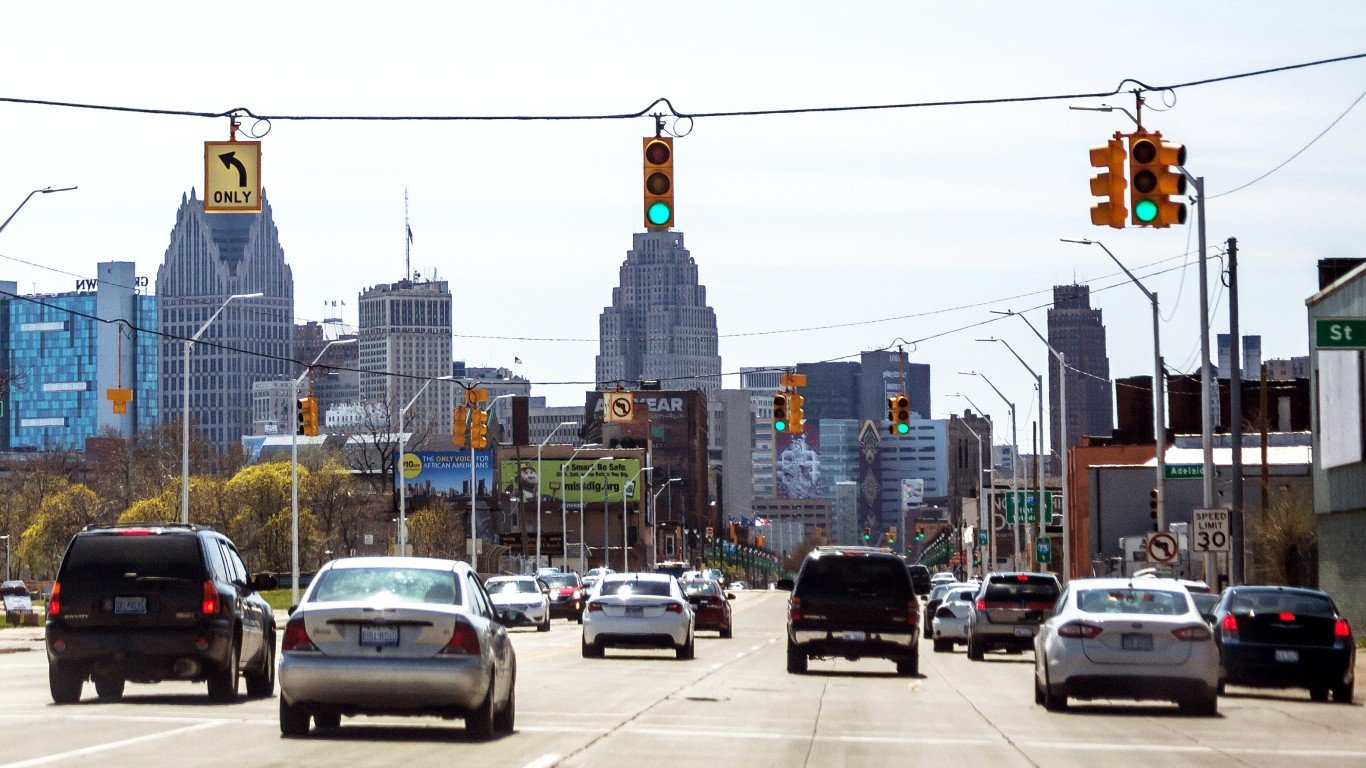 According to 2011 data released on Wednesday by the U.S. Census Bureau, 15% of individuals in the United States live below the poverty line. While down from 15.1% last year, it remains statistically unchanged and near a record high. Today, more than 46 million people live in poverty in America, more than at any point in the country’s history.
According to 2011 data released on Wednesday by the U.S. Census Bureau, 15% of individuals in the United States live below the poverty line. While down from 15.1% last year, it remains statistically unchanged and near a record high. Today, more than 46 million people live in poverty in America, more than at any point in the country’s history.
Read: The 10 Poorest Countries in the World
However, compared to the poorest countries in the world, the poverty rate in the U.S. is relatively modest. In some countries, the poverty rate is more than five times the U.S. current figures. In Haiti, the highest in the world, 77% of residents live in poverty. Based on data from the World Bank, 24/7 Wall St. identified the 10 countries with the highest poverty rates.
The presence of extreme poverty usually coincides with significant obstacles, including limited resources, disease, famine and war. 24/7 Wall St. analyzed how the most impoverished nations ranked in several key areas ranging from level of peace to economic stability, health and education. The poorest countries consistently performed poorly in nearly every case.
Educational attainment and literacy rates are particularly low in these countries. While adult literacy figures were unavailable for many of these nations, those that have reported data were among the worst in the world. In several cases, less than half of eligible children were enrolled in primary education (the equivalent of elementary and middle school). In the Democratic Republic of the Congo, among the poorest countries, less than a third of the relevant population was enrolled in primary education. By comparison, in the United States, nearly 95% were.
Health and healthy decisions are often ignored in these countries. In the 10 nations with the highest poverty rates, HIV prevalence is extremely high. Five of the eight countries for which data are available were in the top 25 (out of more than 200 countries) for HIV cases among people 15 to 49. These include Zimbabwe, which has the fifth-highest HIV/AIDS prevalence rate at 14.3%, and Swaziland, which has the highest recorded rate at 25.9%. In the U.S., the rate is just 0.78%.
Life expectancy, not surprising, is also very low. In the U.S., a person born today is projected to live to the age of 78.2. In each of these countries, life expectancy is less than 60 years. In four of these countries, the average resident will not live to see 50.
24/7 Wall St. relied on World Bank data for the percentage of residents who are living below their national poverty lines. Data was only available for 112 developing nations. In addition, we considered GDP per capita, gross domestic product, HIV/AIDS prevalence, life expectancy, unemployment, infant mortality and primary school enrollment — all from the World Bank. Where current data was not available, data from the most recent available year was used. We also relied on the U.S. Department of State and the Central Intelligence Agency’s World Factbook for additional information on these countries, including the presence of armed conflict and recent natural disasters.
These are the 10 poorest countries in the world.
10. Sao Tome and Principe
Poverty rate: 66.2%
Population: 168,526
GDP: $248 million (5th lowest)
GDP per capita: $1,473 (48th lowest)
Sao Tome and Principe, a country of fewer than 200,000 people off the western coast of Africa, has relied heavily on cocoa production since it became an independent state in 1975. However, production has declined substantially due to drought and mismanagement. While the country stands to benefit from the recent discovery of oil from the Gulf of Guinea, the World Factbook notes that production is likely several years away. Unlike most of the countries on this list, Sao Tome and Principe has a primary school enrollment of 98.3%, which is substantially above the world rate of 88.8%.
9. Sierra Leone
Poverty rate: 66.4%
Population: 5,997,486
GDP: $2.24 billion (36th lowest)
GDP per capita: $374 (4th lowest)
Sierra Leone has significant mineral, agricultural and fishery resources that could lead the country to economic growth. Political stability is slowly helping to improve the fortunes of the country as it recovers from the civil war, which lasted from 1991 to 2002. But while the military has been in charge of the country ever since the war, issues such as corruption still exist. The country has to rely on international aid from organizations such as the International Monetary Fund in order to remain financially solvent, and inflation of 18% in Sierra Leone is a serious problem. Sierra Leone has the highest rate of infant mortality in the world, with 113.7 deaths for every 1,000 live births. Sierra Leone’s life expectancy of just 47.4 years old is the second lowest in the world.
8. Burundi
Poverty rate: 66.9%
Population: 8,575,172
GDP: $2.33 billion (38th lowest)
GDP per capita: $271 (2nd lowest)
In 1993, political differences between Burundi’s two largest ethnic groups, the Hutu and Tutsi, triggered widespread ethnic violence that lasted almost a dozen years. Although this civil war has ended, ethnic conflicts in the region continue. The prolonged conflict, however, is not the only factor keeping Burundians in poverty. Although the country also has limited natural resources and agriculture accounts for just 31% of GDP, more than 90% of the working population is employed in the sector. According to the World Bank, Burundi remains one of the world’s poorer countries on a per capita basis — only one country, the Democratic Republic of Congo, had a GDP per capita figure lower than Burundi’s $271. Burundi’s infant mortality rate of 87.8 deaths per 1,000 live births is more than double the rate worldwide.
Also Read: States Losing the Most Jobs to China
7. Madagascar
Poverty rate: 68.7%
Population: 21,315,135
GDP: $9.95 billion (73rd lowest)
GDP per capita: $467 (7th lowest)
Located in the Indian Ocean east of continental Africa, Madagascar is an island nation of more than a 350,000 square miles in size. Until the mid-1990s, Madagascar was a socialist nation. Though it has since embraced World Bank- and IMF-endorsed economic programs for privatization and participated in the U.S. African Growth and Opportunity Act, the nation has had difficulties meeting the standards expected by these organizations and programs. Despite these programs, the nation’s economy remains largely dependent on agriculture for employment, with 80% of all employed persons working in the sector. In 2011, the country’s GDP per capita was just $467, making Madagascar one of 11 nations with a figure below $500.
6. Eritrea
Poverty rate: 69.0%
Population: 5,415,280
GDP: $2.61 billion (40th lowest)
GDP per capita: $482 (8th lowest)
While hopes for economic growth rest on several international mining projects, 80% of Eritrea’s labor force is employed in the agricultural sector. However, agriculture only represents 11% of the nation’s GDP, with industry comprising 34% and services making up 55%. The country’s only political party, the People’s Front for Democracy and Justice, has implemented policies that rigidly control the use of foreign currency and favors party-owned businesses in the economy. Making matters more difficult for Eritrea, the United Nations imposed economic sanctions on the country in 2009, accusing the government of supporting anti-Ethiopian insurgents in Somalia. Eritrea’s primary school enrollment is only about 33.5%, which is the third-lowest rate in the entire world.
5. Swaziland
Poverty rate: 69.2%
Population: 1,067,773
GDP: $3.98 billion (47th lowest)
GDP per capita: $3,725 (82nd lowest)
A number of factors combine to limit Swaziland’s economic growth, including an over-reliance on exports to South Africa. In addition, the country’s workforce is largely concentrated in subsistence agriculture, even though the country faces serious concerns about overgrazing and soil depletion. While these factors harm the nation’s economy, health concerns are likely one of the major factors preventing Swaziland’s population from escaping poverty. Few nations have a lower life expectancy at birth than Swaziland, where the average person is expected to live just 48.3 years. One of the reasons for the low life expectancy is the high prevalence rate of HIV/AIDS among those 15 to 49 — at 25.9% it is the highest in the world.
4. Congo (Democratic Republic)
Poverty rate: 71.3%
Population: 67,757,577
GDP: $15.64 billion (91st lowest)
GDP per capita: $231 (the lowest)
The Congo has suffered from corruption and conflict in the past 15 years that have “dramatically reduced national output and government revenue, increased external debt, and resulted in the deaths of more than 5 million people from violence, famine and disease,” according to the CIA’s World Factbook. The agency notes that while mining growth has helped boost the country’s economy, much of its economic activity still takes place in the informal sector, which is not counted in GDP statistics. Health and education are very poor in the country. Out of 1,000 children born, 111.7 will die before their first birthday, which is the highest rate in the world except for Sierra Leone. Primary school enrollment of just slightly over 33% is the second worst in the world.
Also Read: The World’s Best (and Worst Economies)
3. Zimbabwe
Poverty rate: 72%
Population: 12,754,378
GDP: $9.9 billion (72nd lowest)
GDP per capita: $776 (25th lowest)
Zimbabwe has effectively had one leader, Robert Mugabe, since it became a sovereign nation in 1980. Mugabe’s tenure has been marked by a violent land redistribution program that has harmed agriculture — a sector that has served as a source of exports and jobs for the nation. Until 2009, Zimbabwe also experienced a problem with hyperinflation. One dollar was worth 9,686.9 Zimbabwean dollars in 2007 and a stunning 430,972.7 Zimbabwean dollars in 2008. In 1993, the nation’s poverty rate was just under 35% of the population. Since then, the poverty rate has more than doubled to 72%.
2. Equatorial Guinea
Poverty rate: 76.8%
Population: 720,213
GDP: $19.79 billion (99th lowest)
GDP per capita: $27,478 (40th highest)
Oddly enough, the country with the second-highest poverty rate in the world has a GDP per capita of $27,478, well above the average worldwide figure of $10,034. However, while extraction of oil and gas has led to economic growth, most of Equatorial Guinea’s population still relies on subsistence farming. The government has been criticized for the mismanagement of its revenue from energy resources. The health and well-being of its citizens would support the critique. Despite its oil wealth, the nation is among the worst countries in the world for life expectancy, at just 50.8 years, and for primary education enrollment, at just 56.3% of the relevant population.
1. Haiti
Poverty rate: 77%
Population: 10,123,787
GDP: $7.35 billion (66th lowest)
GDP per capita: $726 (22nd lowest)
The World Bank notes that more than half of Haiti’s population lives on less than $1 a day, while about 80% of the country lives on less than $2 a day. The country’s estimated unemployment rate as of 2010 was 40.6%. The impoverished nation is in a state of rebuilding since a devastating earthquake hit the country in 2010. According to a USAID report, the death toll from the earthquake was between 46,000 and 85,000, while the official figure by the Haitian government estimated the death toll at 316,000. The World Bank estimates that damages from earthquake totaled $8 billion, or about 120% of gross domestic product.
Michael B. Sauter, Alexander E. M. Hess and Samuel Weigley
Also Read: America’s 10 Disappearing Jobs
Take This Retirement Quiz To Get Matched With An Advisor Now (Sponsored)
Are you ready for retirement? Planning for retirement can be overwhelming, that’s why it could be a good idea to speak to a fiduciary financial advisor about your goals today.
Start by taking this retirement quiz right here from SmartAsset that will match you with up to 3 financial advisors that serve your area and beyond in 5 minutes. Smart Asset is now matching over 50,000 people a month.
Click here now to get started.
Thank you for reading! Have some feedback for us?
Contact the 24/7 Wall St. editorial team.



